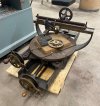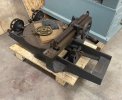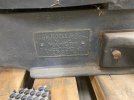Scratchmo
Elite Cafe Member
A Cronite ruling machine. I've had it around for a while and now thinking about selling it but I have no clue where to even start on value. I realize this is the Hand Engraving forum, but these machines were used by Banknote engravers in addition to hand engraving to scribe and etch very fine, exacting lines for borders, background shading, etc. It will also do concentric circles. If anyone has any idea of value, I'd appreciate it. Please move to proper forum if this is not acceptable.
It's my impression that this one is somewhat rare and top of the line for Cronite 'straight line' machines because of the rotary table that can do concentric circles and arcs.


It's my impression that this one is somewhat rare and top of the line for Cronite 'straight line' machines because of the rotary table that can do concentric circles and arcs.









